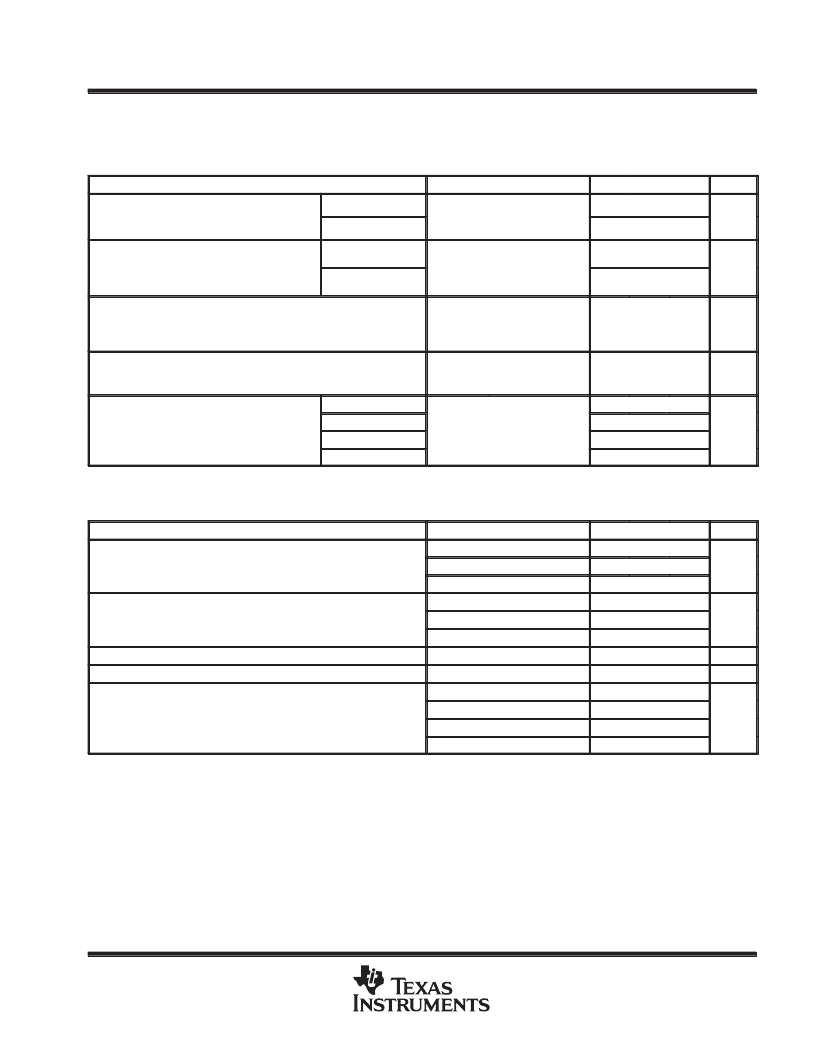- 您現(xiàn)在的位置:買賣IC網(wǎng) > PDF目錄383935 > TCM38C17IDLDL (Texas Instruments, Inc.) QComboE FOUR-CHANNEL QUAD PCM COMBO PDF資料下載
參數(shù)資料
| 型號: | TCM38C17IDLDL |
| 廠商: | Texas Instruments, Inc. |
| 英文描述: | QComboE FOUR-CHANNEL QUAD PCM COMBO |
| 中文描述: | QComboE四通道的Quad的PCM組合 |
| 文件頁數(shù): | 7/22頁 |
| 文件大小: | 314K |
| 代理商: | TCM38C17IDLDL |

TCM38C17IDL
QCombo
FOUR-CHANNEL (QUAD) PCMCOMBO
SLWS040C – JUNE 1996 – REVISED OCTOBER 1999
7
POST OFFICE BOX 655303
DALLAS, TEXAS 75265
electrical characteristics over recommended ranges of supply voltage and operating free-air
temperature (unless otherwise noted) (continued)
power supply rejection and crosstalk attenuation over recommended ranges of supply voltage and
operating free-air temperature
PARAMETER
TEST CONDITION
MIN
TYP
MAX
UNIT
VDDsupply voltage rejection transmit channel
VDD supply voltage rejection, transmit channel
0 < f < 30 kHz
Idle channel,
Supply signal = 200 mVpp,
f measured at PCMOUT
–40
dB
30 < f < 50 kHz
–45
VDD supply voltage rejection,
(single-ended)
0 < f < 30 kHz
Idle channel,
Supply signal = 200 mVpp,
ly signal 200 mV
narrow-band,
f measured at PWRO+
–40
dB
30 < f< 50 kHz
–45
Crosstalk (same channel) attenuation, transmit-to-receive
(single-ended)
ANLGIN+ = 0 dBm0,
f = 1.02 kHz, unity gain,
PCMIN = lowest decode level,
measured at PWRO+
≤
100
–75
dB
Crosstalk (same channel) attenuation, receive-to-transmit
(single-ended)
PCMIN = 0 dBm0,
f = 1.02 kHz,
measured at PCMOUT
≤
100
–75
dB
Transmit to transmit
≤
100
≤
100
≤
100
≤
100
–76
Crosstalk (between channels) attenuation
Transmit to receive
0 dBm0,
300 Hz – 3400 Hz
–78
dB
Receive to transmit
Receive to receive
–76
–78
All typical values are at VDD = 5 V, and TA = 25
°
C
Actual levels were beneath the test equipment measurement floor.
distortion over recommended ranges of supply voltage and operating free-air temperature
PARAMETER
TEST CONDITIONS
0 > ANLGIN > –30 dBm0
MIN
36
MAX
UNIT
Transmit signal to distortion ratio, sinusoidal input (CCITT G.712 -
Method 2)
it i
l t di t ti
id l i
t (CCITT G 712
–30 > ANLGIN > –40 dBm0
30
dB
–40 > ANLGIN > –45 dBm0
25
Receive signal to distortion ratio, sinusoidal input (CCITT G.712 -
Method 2)
l t di t ti
id l i
t (CCITT G 712
0 > ANLGIN > –30 dBm0
36
–30 > ANLGIN > –40 dBm0
30
dB
–40 > ANLGIN > –45 dBm0
25
Transmit single-frequency distortion products
Input signal = 0 dBm0
–46
dBm0
Receive single-frequency distortion products
Input signal = 0 dBm0
–46
dBm0
CCITT G.712 (7.1)
–35
Intermodulation distortion, end-to-end
Spurious out-of-band signals, end-to-end
CCITT G.712 (7.2)
–49
dBm0
CCITT G.712 (6.1)
CCITT G.712 (9)
–25
–40
相關(guān)PDF資料 |
PDF描述 |
|---|---|
| TCM38C17 | () |
| TCM809JELB713 | 3-Pin Microcontroller Reset Monitors |
| TCM809JENB713 | 3-Pin Microcontroller Reset Monitors |
| TCM809JVLB713 | 3-Pin Microcontroller Reset Monitors |
| TCM809JVNB713 | 3-Pin Microcontroller Reset Monitors |
相關(guān)代理商/技術(shù)參數(shù) |
參數(shù)描述 |
|---|---|
| TCM38C17IDLR | 制造商:Texas Instruments 功能描述:Audio Codec 1ADC / 1DAC 48-Pin SSOP T/R |
| TCM4110 | 制造商:TI 制造商全稱:Texas Instruments 功能描述:PCM U-LOW COMPANDING CODES |
| TCM4205J4 | 制造商:Texas Instruments 功能描述: |
| TCM4-23-2+ | 制造商:MINI C 功能描述: |
| TCM4-25 | 制造商:Mini-Circuits 功能描述:500 MHz - 2500 MHz RF TRANSFORMER |
發(fā)布緊急采購,3分鐘左右您將得到回復(fù)。